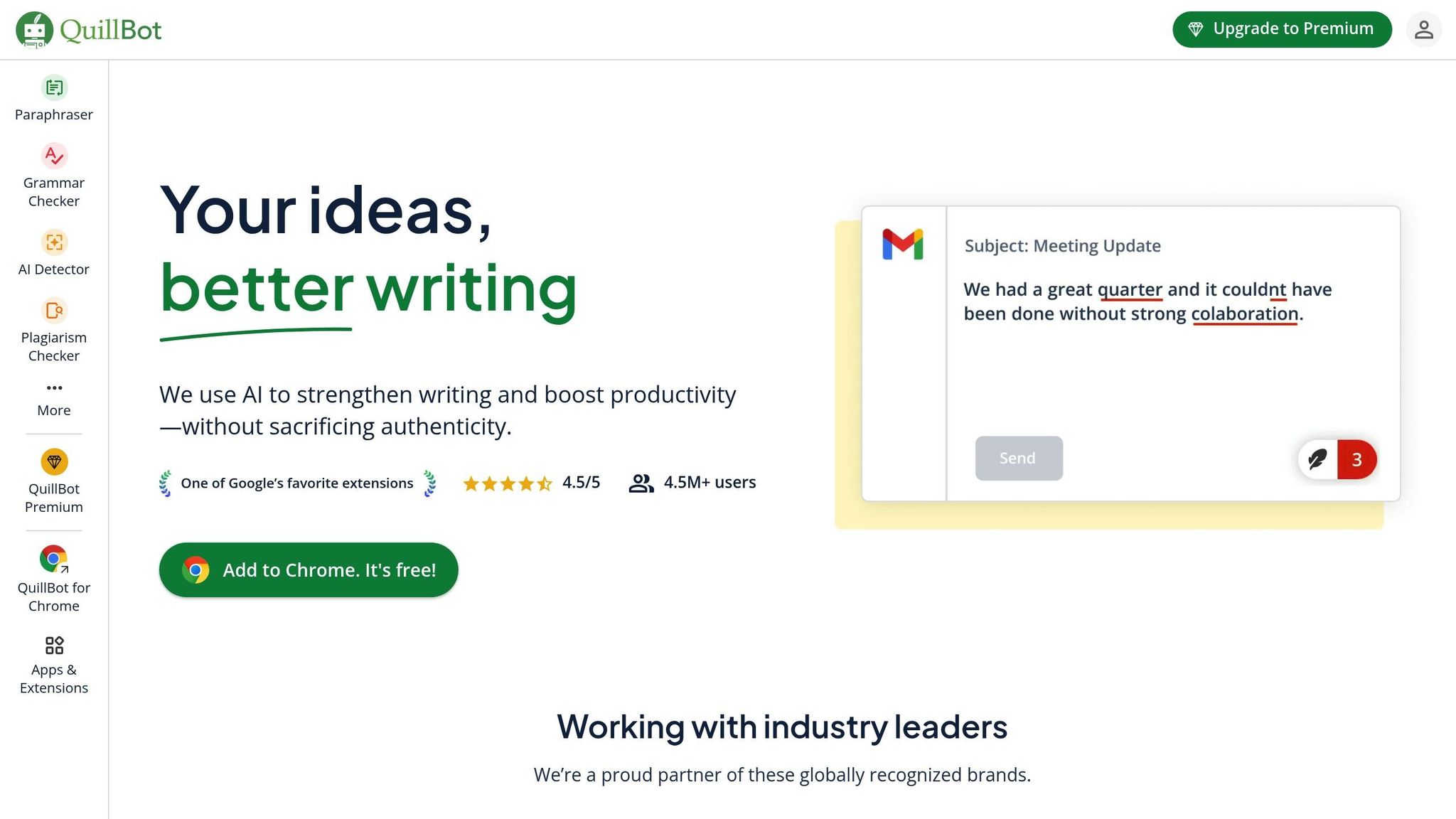Is Quillbot’s AI Detector Trustworthy? We Tested It Against Other AI Checkers
QuillBot AI Detector, launched in July 2024, is designed to classify text like AI-generated, human-written, and hybrid content. It achieves an 80% accuracy rate, but struggles with mixed AI-human texts and short inputs under 80 words. Here’s a quick breakdown of its performance and competitors:
QuillBot AI Detector: Key Points:
- Accuracy: QuillBot detects AI content with 78-80% accuracy, but competitors like Scribbr (84%) and GPTZero (99.5%) perform better.
- Strengths: Supports multiple languages (English, Spanish, German, French) and offers sentence-level analysis.
- Limitations: High false positives, struggles with complex or hybrid content, and requires a minimum of 80 words.
QuillBot AI Detector: Quick Comparison
| Tool | Accuracy | False Positives | Key Feature | Cost (Premium) |
|---|---|---|---|---|
| Scribbr | 84% | 0 | Best overall accuracy | $10/month |
| QuillBot | 78-80% | Occasional | Multi-language support | $99.95/year |
| GPTZero | 99.5% | Low | Best for detecting GPT-4 | $20/month |
| Originality.AI | 76% | 1 | Paraphrased content detection | $0.01/credit |
| Copyleaks | 66% | 0.2% | Claims 99% accuracy | $9.99/month |
QuillBot AI Detector: Battle of the AI Detectors. Turnitin VS Originality VS QuillBot.

1. Quillbot AI Detector Analysis
Introduced in July 2024, QuillBot’s AI Detector requires at least 80 words to deliver accurate predictions. It relies on advanced pattern recognition to spot typical markers of AI-generated content, such as repetitive phrasing, overly formal language, and consistent sentence structures.
Independent reviews have noted an overall detection accuracy of about 80%. In controlled tests, its performance stood out with the following results:
| Content Type | Detection Accuracy |
|---|---|
| Blog Posts | 100% |
| Case Studies | 100% |
| Promotional Emails | 100% |
| Paraphrased Content | 96% |
The tool works by analyzing input text against an extensive database of AI writing patterns and models, producing a percentage score that indicates the likelihood of AI involvement. However, testing has shown that the detector can be overly sensitive, which might lead to more false positives. These insights help in assessing its features and comparing its performance with other AI detection tools.
2. BeLikeNative Features

BeLikeNative is a Chrome extension designed to improve writing efficiency by refining text effortlessly across various platforms. With support for over 80 languages, it ensures text sounds natural and polished.
The platform offers multiple subscription plans, each tailored to different needs:
| Plan | Character Limit | Daily Uses | Features |
|---|---|---|---|
| Explorer | 500 | 5 uses | Basic spelling and grammar corrections, along with clarity improvements. |
| Learner | 2,000 | 25 uses | Includes Explorer features, plus editable options and keyboard shortcuts. |
| Native | 4,000 | 50 uses | Offers advanced editing tools and faster processing during busy periods. |
| Premium | 6,000 | 125 uses | Comprehensive editing tools, ideal for high-demand tasks and partnerships. |
BeLikeNative also integrates smoothly with popular platforms. Its clipboard functionality allows users to refine content instantly using a simple shortcut. The extension works seamlessly with tools like WhatsApp Web, Google products, and Notion.
Users can personalize their writing by adjusting language, tone, and style. The Premium plan is particularly suited for handling long-form content, ensuring top performance even during high-traffic periods.
sbb-itb-32359dc
3. Common AI Detection Tools & QuillBot AI Detector:
After analyzing QuillBot, we extended our testing to evaluate other widely-used AI detection tools. The results revealed differences in accuracy, with Scribbr emerging as the most precise, achieving an 84% accuracy rate and zero false positives.
Here’s a closer look at the top-performing tools:
| Tool | Accuracy | False Positives | Star Rating |
|---|---|---|---|
| Scribbr (Premium) | 84% | 0 | 4.2 |
| QuillBot | 78% | 0 | 3.9 |
| Originality.AI | 76% | 1 | 3.7 |
| Sapling | 68% | 0 | 3.4 |
| CopyLeaks | 66% | 0 | 3.3 |
These figures offer a useful comparison before diving into specific challenges and limitations identified during testing.
Observations from Testing QuillBot AI Detector:
- GPT-4 outputs are more challenging to detect compared to GPT-3.5.
- Detection accuracy drops with mixed AI-human texts, paraphrased content, and technical subject matter.
- Originality.AI successfully identified paraphrased text in 60% of cases.
- Content at Scale showed strong performance, detecting 90% of AI-written material.
Common Limitations of AI Detectors QuillBot AI Detector:
- Restrictions on word count
- Difficulty handling minor text edits
- Reduced reliability with mixed human-AI content
- Lower accuracy for highly specialized topics
Although no tool currently achieves perfect accuracy, the top options continue to improve in identifying AI-generated content. For specific use cases, Copyleaks reports over 99% accuracy with a very low false positive rate of just 0.2%. The AI detection field is advancing steadily, but challenges remain.
QuillBot AI Detector: Advantages and Limitations
Testing highlights both the strengths and weaknesses of Quillbot’s AI Detector.
QuillBot AI Detector: Key Advantages
Quillbot’s AI Detector offers detailed classification of content, identifying whether it’s AI-generated or human-written. Users can analyze up to 2,500 words daily for free. The premium plan, priced at $99.95 per year, increases the limit to 25,000 words monthly, making it a budget-friendly option for both individuals and organizations.
QuillBot AI Detector: Notable Limitations
Despite its benefits, the tool has several drawbacks:
| Limitation Type | Description | Impact |
|---|---|---|
| Word Count Requirement | Requires at least 80 words for analysis | Unsuitable for very short texts |
| Detection Accuracy | Accuracy rate of 78% | Falls short of competitors (84%) |
| Content Mixing | 50% accuracy with hybrid content | Struggles with mixed AI-human text |
| False Positive Risk | Occasionally mislabels human content | Could affect legitimate evaluations |
These issues can lead to inconsistent detection results, particularly in complex cases.
Performance in Specific Scenarios
The detector performs better with pure AI or human-generated content compared to hybrid text. It excels in analyzing blog posts, academic papers, and similar formats but may show reduced reliability as content complexity increases.
Technical Implementation
Quillbot’s detection relies on advanced algorithms that identify patterns like repeated words, awkward phrasing, and unnatural flow. While these features set it apart, they also highlight its limitations compared to higher-accuracy tools, shaping its position in the market.
QuillBot AI Detector: Final Assessment
Based on the testing and analysis, Quillbot’s AI Detector achieves an average accuracy of 80%, indicating mixed reliability.
Best Use Cases
The AI Detector works well for:
- Verifying basic content in blog posts and academic papers
- Screening longer texts (over 80 words)
- Handling multi-language detection in English, Spanish, German, and French
- Supporting human review as a secondary tool
Critical Considerations
Quillbot’s AI Detector should be seen as a supplementary tool. With an accuracy of 80%, it lags behind competitors like GPTZero, which boasts 99.5% accuracy. The detector’s tendency to produce false positives makes it unsuitable as a standalone solution. These limitations impact its overall reliability, as outlined below.
Value Assessment
Priced at $99.95 per year for premium access, Quillbot’s AI Detector provides a reasonable option for users seeking a combined writing and AI detection tool. However, for those prioritizing highly accurate AI content verification, it may not be the best choice. Its standout feature lies in its integration within a broader writing platform, rather than excelling as a dedicated AI detection tool.
The detector is particularly helpful for identifying fully AI-generated text versus hybrid content, which is useful for creators combining various sources. However, the 80-word minimum for analysis and the inability to process non-text content, such as images or videos, limit its versatility in certain contexts.
Conclusion:
QuillBot is a decent option for basic AI detection, especially for multilingual tasks, but its accuracy and false positives mean it’s better as a secondary tool rather than a primary solution. For higher accuracy, consider alternatives like Scribbr or GPTZero.



1 Comments
Best AI Checker of 2025: Top 17 Detectors Compared
November 19, 20256:34 am
[…] free AI detection tools with its easy-to-use interface and detailed coverage. Tests show it reaches 78-80% accuracy, making it a reliable choice for everyday content […]
Comments are closed.